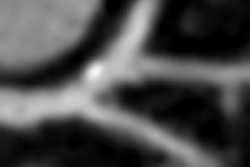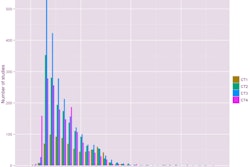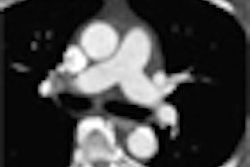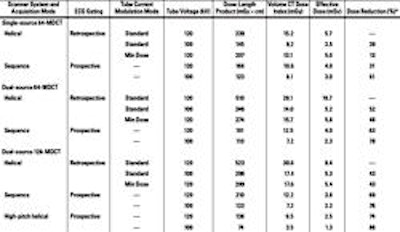
A study in the May American Journal of Roentgenology compared three CT scanners at coronary CT angiography (CTA). The results showed that protocols were more important than scanner model in determining dose, with effective dose reductions of 40% to 50% achieved by reducing tube current from 120 to 100 kV.
In addition, single-source CT showed lower dose than dual-source when retrospective gating was used, while the lowest doses were achieved using a high-pitch protocol and a second-generation dual-source scanner.
Coronary CTA is becoming an accepted method of ruling out coronary artery disease, but radiation dose remains a concern, and several previous studies have shown large variations in doses ranging up to 30 mSv, wrote Dr. Christian Fink, Dr. U. Joseph Schoepf, and colleagues from Mannheim-Heidelberg University and the Medical University of South Carolina.
A number of methods can be used to reduce the dose, such as tube current modulation and prospective electrocardiogram (ECG) triggering, but direct comparisons of coronary CTA dose levels are not available in the literature, according to the authors. "Despite measures to stratify patients according to age, sex, heart rate, scan range, weight, and body mass index, these studies have not allowed objective direct comparison ... because radiation dose is strongly influenced by individual patient parameters," they wrote (AJR, May 2011, Vol. 196:5, pp. W550-W557).
Fink and his colleagues aimed to assess radiation dose in four coronary CTA protocols on three scanners: a single-source 64-detector-row scanner (Somatom Definition 64 AS), a first-generation dual-source 64-detector-row scanner (Somatom Definition), and a second-generation dual-source 128-detector-row scanner (Somatom Definition Flash), all from Siemens Healthcare.
The researchers placed thermoluminescent dosimeters (TLDs) in an anthropomorphic phantom representing a patient with a height of 175 cm and weight of 73.5 kg (body mass index, 23.9). An external stimulator was used to simulate a heart rate of 60 bpm. The TLDs were used to determine scanner-specific dose coefficients for standard coronary CTA; the coefficients were then used to estimate effective doses of retrospectively gated, prospectively triggered, and prospectively triggered high-pitch coronary CTA performed at 100 and 120 kV.
Also analyzed were signal-to-noise ratio and subjective image quality (scale of 1 to 5, with 5 meaning excellent) to assess the potential effects of dose reduction on image quality. Differences in radiation dose using overranging were also considered for each scanner. Default imaging protocols from the manufacturer were used to evaluate the research protocols, the authors wrote.
In an effort to verify that radiation doses obtained with the phantom measurements were representative of clinical studies, the group also recorded dose-length product and volume CT dose index for coronary CTA in 43 consecutive patients using a dual-source 128-MDCT system and different coronary CTA protocols.
Results
The researchers found that regardless of coronary CTA protocol and CT system, imaging at 100 kV lowered the effective dose by 40% to 50% -- slightly greater dose savings than previously reported.
For retrospectively gated 120-kV coronary CTA, the effective doses were 5.7, 10.7, and 9.4 mSv with single-source 64-detector-row CT, dual-source 64-detector-row CT, and dual-source 128-detector-row CT, respectively.
Decreasing the tube voltage to 100 kV reduced the radiation dose of standard retrospectively gated coronary CTA to 3.5 mSv (-39%) with the single-source 64-detector-row system, 5.2 mSv (-52%) with the dual-source 64-detector-row system, and 5.3 mSv (-43%) with the dual-source 128-detector-row system.
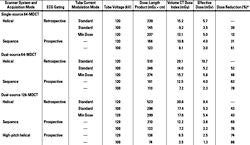 |
| Click here to enlarge this image. |
| Table shows effective radiation doses for coronary CTA performed with different CT systems. |
Doses were approximately 50% lower with single-source 64-detector-row CT than with either dual-source CT (DSCT) protocol.
"DSCT was designed to optimize the temporal resolution of coronary CTA for acquisition of motion-free images of the coronary arteries at all heart rates" by acquiring data from two x-ray tubes simultaneously, the authors explained. DSCT's increased temporal resolution can also be used to reduce the radiation dose versus single-source CT by increasing the pitch and using a smaller tube current modulation pulse width. However, the effect is more pronounced with higher heart rates than the 60 bpm generated in the phantom, they wrote.
"In the comparison of the two DSCT systems, the radiation dose for standard retrospectively gated coronary CTA was slightly lower with the dual-source 128-MDCT system," they added.
This finding might result from the use of adapted shield technology on the dual-source 128-detector-row CT system but not the earlier-generation dual-source 64-detector-row scanner. The later DSCT model also uses a technology that locally reduces the effective dose to radiosensitive organs by reducing tube current during the phase in which the organ is directly exposed to the beam.
ECG-dependent tube-current modulation yielded dose-reduction benefits ranging from 13% to 46%, compared with CTA performed with standard tube-current modulation, the authors wrote. In addition, the dose-reduction potential of ECG-dependent tube-current modulation was approximately twice as high with dual-source CT versus single-source CT.
Similar dose values were seen for phantom and patient measurements performed with the standard coronary CTA protocols and the dual-source 128-detector-row system. However, use of the prospectively ECG-triggered sequential acquisition mode raised the effective dose substantially in patients compared to the phantom. This was partly due to higher-than-average body mass index in the patients; however, reducing the tube voltage from 120 kV to 100 kV rendered the patient dose using sequential mode only slightly higher than that of the phantom, Fink and colleagues explained.
In prospectively triggered 120-kV coronary CTA, the effective dose ranged from 3.8 mSv (single source) to 4.0 mSv (dual source). Decreasing the tube voltage to 100 kV resulted in further dose reduction to 3.0, 2.3, and 2.2 mSv.
The lowest effective dose (1.3 mSv) was seen in prospectively gated high-pitch 100-kV coronary CTA performed with the dual-source 128-detector-row scanner. At 100 kV, the dose reduction potential was 86% compared to the standard retrospectively gated protocol performed with the same scanner type at 120 kV.
"The combination of a prospectively gated sequential mode with low tube voltage settings is an effective measure for reducing the effective dose of coronary CTA to values of 2-4 mSv independent of the CT system," the authors concluded. Doses as low as 1.3 mSv can be achieved using a high-pitch coronary CTA protocol on a second-generation dual-source 128-detector-row scanner.





